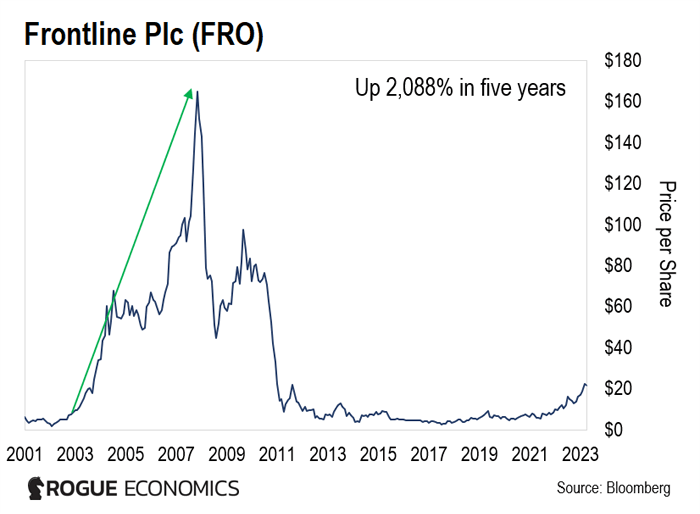Sanctions on Russian energy products…
The Biden administration’s decision to drain the U.S.’ emergency oil stockpile…
Production cuts by OPEC, the world’s biggest oil cartel…
Any one of those events is enough to roil energy markets.
But today, they’re all happening at the same time. That means more industries are being ensnared in the scramble to secure energy supplies.
It’s one of the biggest megatrends Inside Wall Street editor Nomi Prins is following. And in these pages, we’ve already shown you how this energy distortion is reshaping the global energy supply chain…
Whether that’s uranium coming from Russia, or the U.S. emerging as a global power in liquified natural gas.
And now, we’re seeing the next distortion fall into place with an obscure energy industry… one that plays a vital role in the global energy trade.
I’m talking about oil tankers that take crude oil from producing nations and transport it to where it’s needed. Like a refinery where oil is turned into fuel products like gasoline.
But following years of underinvestment, the tanker industry is on a collision course with supply and demand trends.
We’ve seen this kind of “supercycle” before… And it led to windfall profits and dividends for those who spotted the trend early.
New Supercycle in the Making
The oil tanker industry is infamous for its boom-and-bust cycles. These are alternating periods of growth and decline in the industry.
And those boom times can deliver windfalls for tanker companies in a short period of time.
As one ocean freight executive from Navios (NMM) put it: “Containers didn’t make a dime for 10 years. Then in two years, they made a decade’s worth of money.”
He’s talking about the Covid-era lockdowns, which generated huge demand for goods from people stuck at home. And that drove up rates for container ships.
The same executive also alluded to what we’re seeing today… That is, the right conditions are aligning for oil tankers.
And when that happens, huge money can be made. Past booms are a case in point, like the last supercycle that peaked in 2008.
Just take a look at Frontline (FRO) from the last major cycle. The stock price soared 2,088% in just five years. You can see that in the chart below…

Other tanker stocks surged as well. For example, Tsakos Energy Navigation (TNP) gained 570%. And Nordic American Tankers (NAT) rose 433% over the same period.
But here’s something else. Many tanker companies have a policy of returning excess profits to shareholders in the form of dividends.
During the good times, dividend yields can reach well into the double digits.
At one point, Frontline was paying out so much income that its dividend yield was over 30%. Nordic’s yield jumped as high as 24%.
And I believe we have the makings of the next tanker supercycle heading into 2024. That’s because demand and supply are on a collision course.
On a Collision Course
Oil tankers are massive vessels that move anywhere from 600,000 to 2 million barrels of oil in a single haul. The biggest are referred to as “very large crude carriers” (VLCCs).
Because of their size and complex construction process, it takes at least two years to build and deliver new tankers once the order is placed.
And right now, the amount of new capacity set to come into the tanker market is at an all-time low. In fact, only one VLCC is being added to the fleet next year.
And that’s not the only thing putting a cap on supply. Older ships are being retired, too. This means that the tanker supply is constrained through at least 2026.
At the same time, there are signs that tanker rates are about to skyrocket. That’s due to rising oil demand.
The International Energy Agency (IEA) is forecasting record-breaking oil demand this year. Global oil demand already hit a record high of 103 million barrels per day back in August.
With OPEC’s production cuts, nations are rushing to secure supplies elsewhere. In fact, there’s a record 48 tankers headed for U.S. shores to load up on oil.
Eventually, OPEC’s production will come back to the market. That will result in even more oil for tanker companies to move.
Timing Is Key
Demand for oil, rising production, a tight tanker supply… It’s a recipe for rising tanker rates. And higher rates mean higher earnings.
And that trend is already starting.
Just over a month ago, the CEO of Nordic commented that quarterly earnings are running 50% higher than the average for the past 10 years.
Tanker rates are volatile and will swing wildly over the near term. But the delicate balance of tanker supply and oil demand is already starting to show up in higher rates.
And it’s not just Nordic.
Euronav, the largest NYSE-listed independent oil tanker company, noted that VLCC rates are running 38% higher than their long-term average.
All of this is setting up an opportunity for investors. But the window to get in might not be open for long…
As you can see from the chart above, tanker stocks aren’t buy-and-hold investments. Tanker stock prices follow the boom-and-bust trends of the tanker cycle.
That’s why timing is key.
To take advantage, we recently added one tanker stock at Nomi’s Energy Distortion Monitor letter. And, given the conditions favoring the industry, we’re on the hunt for more opportunities.
If you’re not paid-up yet, now is a good time to learn more about an Energy Distortion Monitor subscription right here.
Regards,
Clint Brewer
Analyst, Inside Wall Street with Nomi Prins